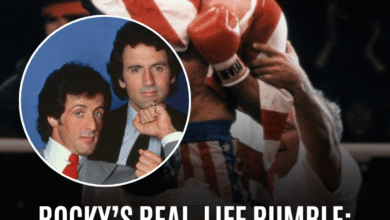Audrey Hepburn’s Untold Setbacks: The Road to Stardom Wasn’t Always Glamorous
OPINION: This article may contain commentary which reflects the author's opinion.
Audrey Hepburn, one of the most beloved and iconic actresses in cinematic history, faced numerous challenges and setbacks throughout her career. From the hardships of her childhood to the pressures of Hollywood stardom, Hepburn’s journey was not without its lows. However, her ability to overcome these obstacles, reinvent herself, and eventually find fulfillment in unexpected ways speaks to her resilience and enduring strength.
Early Life and Career Struggles
Audrey Hepburn’s early life was marked by significant adversity. Born in 1929 in Brussels, Belgium, Hepburn lived through the hardships of World War II in Nazi-occupied Holland. During this time, she endured malnutrition, which led to acute anemia and respiratory problems, affecting her physical health and growth. This difficult period would shape not only her personal life but also her career trajectory.
Initially, Hepburn pursued a career in classical ballet, studying under the renowned Marie Rambert. However, her height (5′ 7″) and lack of muscle tone—consequences of her malnourished childhood—prevented her from achieving success as a ballet dancer. Rambert, who had been a key influence on Hepburn, discouraged her from pursuing a leading ballet role due to the difficulty of finding taller male dancers, a pivotal moment that forced Hepburn to pivot to acting. This transition marked the end of one career aspiration and the beginning of another, setting the stage for her acting career.
Early Acting Career: Humble Beginnings
Hepburn’s acting career began with small roles, including performing as a chorus girl in Broadway musicals like High Button Shoes (1948–1949) and Sauce Tartare (1949), as well as uncredited roles in films like One Wild Oat (1951) and Laughter in Paradise (1951). These early roles were far from the stardom she would eventually achieve, representing a low point in her career in terms of recognition and opportunity. Yet, these humble beginnings served as stepping stones, giving Hepburn the experience and resilience necessary to face the challenges ahead.
Mid-Career Setbacks and Typecasting
As Hepburn’s fame grew, especially following her breakthrough role in Roman Holiday (1953), she began to encounter new challenges. Her portrayal of the charming Princess Ann earned her an Academy Award and solidified her status as a Hollywood leading lady. However, her role as Holly Golightly in Breakfast at Tiffany’s (1961) would lead to a new struggle—typecasting.
The success of Breakfast at Tiffany’s cemented Hepburn as a fashion and film icon, but it also led to her being repeatedly offered similar roles, such as “a batty hooker in a black dress.” These roles were often superficial and constrained her ability to explore more diverse and complex characters. The Guardian highlights this struggle, noting that Hepburn was often limited by Hollywood’s perception of her as a certain type of character, a form of typecasting that proved to be a significant career low for her.
Another setback came during the production of My Fair Lady (1964), where her singing limitations became apparent. Hepburn was not a strong singer, and her voice was dubbed by Marni Nixon, a decision she later learned about, potentially affecting her confidence and public perception. This issue, combined with her decision to turn down roles such as that of Anne Frank, feeling she was too old for the part, contributed to a feeling of frustration during this period.
Films like Green Mansions (1959) and Paris When It Sizzles (1964) further added to the pressure, as these films were less successful both critically and commercially, amplifying the challenges Hepburn faced in maintaining her star status.
Later Career and Personal Struggles
The 1970s and 1980s saw a significant decrease in Hepburn’s film roles. After They All Laughed in 1981, she did not appear in any films until her cameo in Always in 1989, marking an eight-year gap. This slowdown in her acting career was influenced by her focus on motherhood and a lack of appealing roles, contributing to a period of professional decline. Hepburn’s final film appearance in Always (1989) was a bittersweet conclusion to a career that had once been marked by groundbreaking roles.
Personal struggles also weighed heavily on Hepburn’s career. She faced difficulties in her relationships, including a challenging marriage to actor Mel Ferrer, and experienced emotional tolls from multiple miscarriages. The production of Wait Until Dark (1967) was particularly stressful, as it was produced by Ferrer during their impending divorce, adding personal strain to her professional life.
Overcoming Challenges: Resilience and Adaptability
Despite the challenges she faced, Hepburn’s ability to adapt and overcome setbacks was one of the defining aspects of her career. When ballet was no longer a viable path, she transitioned into acting, achieving success with her breakout performance in Roman Holiday and later with Breakfast at Tiffany’s and My Fair Lady. These roles, though they led to typecasting, also allowed Hepburn to showcase her talent and charm, making her a lasting icon in film history.
Hepburn’s mindset of resilience is encapsulated in her quote, “I believe in being strong when everything seems to be going wrong,” a philosophy she applied to both her personal and professional life. She was known for her ability to endure personal and professional hardships with grace, which allowed her to continue finding fulfillment even when her acting career slowed.
A Shift Toward Humanitarian Work
As her acting career slowed in the late 1980s, Hepburn found new purpose in humanitarian work. In 1988, she became a Goodwill Ambassador for UNICEF, dedicating herself to helping children in need around the world. This shift marked a career high point for Hepburn, as she found fulfillment in a cause that she considered more important than her film career. Hepburn once said that her humanitarian work was her greatest achievement, highlighting the deep satisfaction she derived from making a positive impact on the world.
Conclusion: The Legacy of Audrey Hepburn
Audrey Hepburn’s career was defined not only by its highs but also by its lows. From the challenges of early malnutrition to the frustrations of typecasting and personal struggles, Hepburn faced numerous obstacles. However, her ability to navigate these difficulties, adapt to new circumstances, and ultimately find fulfillment in humanitarian work serves as a powerful testament to her resilience.
Her legacy endures not only through her iconic film roles but also through her enduring commitment to making the world a better place. Hepburn’s career lows did not define her—they were simply chapters in a life that was ultimately marked by grace, strength, and an unwavering desire to help others.



